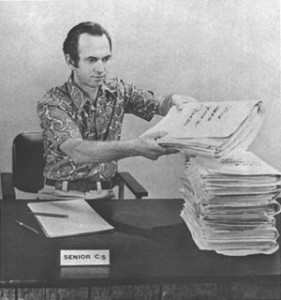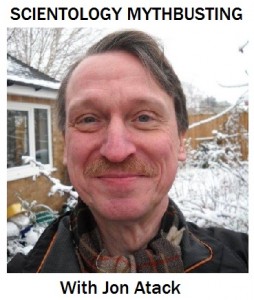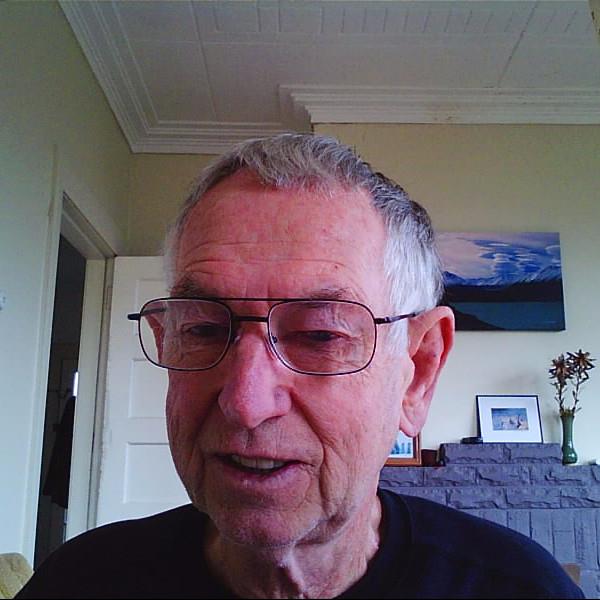 Jon Atack is the author of A Piece of Blue Sky, one of the very best books on L. Ron Hubbard and Scientology. He now has a new edition of the book out, and on Saturdays he’s helping us sift through the legends, myths, and contested facts about Scientology that tend to get hashed and rehashed in books, articles, and especially on the Internet.
Jon Atack is the author of A Piece of Blue Sky, one of the very best books on L. Ron Hubbard and Scientology. He now has a new edition of the book out, and on Saturdays he’s helping us sift through the legends, myths, and contested facts about Scientology that tend to get hashed and rehashed in books, articles, and especially on the Internet.
Jon, there’s a large and active “independent” movement that has split away from the church and gets a lot of news coverage. But throughout its history Scientology has experienced schisms and breakaway groups. In particular, David Mayo’s “Advanced Ability Center” in Santa Barbara comes to mind. What are the basics that we should know about Mayo, his involvement in the upper level materials, and why church leader David Miscavige considered him such a threat?
JON: By 1982, David Mayo was regarded as Hubbard’s successor. Scientologists thought of him as the greatest of experts on the “technology” — or counseling procedures. Members were told that in 1978 Mayo had saved L. Ron Hubbard’s life by repairing mistakes and errors in his auditing, largely made while Hubbard had been auditing himself. Out of that work Mayo also helped develop New Era Dianetics for OTs or NOTs, which became New OT V a few years later.
THE BUNKER: Kima Douglas said that Hubbard had suffered a pulmonary embolism in 1975, and then in 1977-78 was very ill again, but he made her promise not to take him to a hospital. Instead, he turned to Mayo to audit him through his sickness, right?
JON: Yes, precisely so.
Mayo had succeeded to the fatal position of Hubbard’s auditor — all before him had failed and been cast into the outer darkness, including the first Class XII and supposed OT VIII, Otto Roos. As Hubbard’s auditor, Mayo had access to the great mass of auditing records of the Great OT. Like Roos, he found a great deal of discreditable material therein, including Hubbard’s astonishing multiple drug abuse. Hubbard said that people who “rock-slammed” on the e-meter had evil intentions, and, as Roos found earlier, Hubbard’s folders were littered with “rock slams.”
THE BUNKER: A “rock slam” meaning a particularly violent reaction by the e-meter’s indicator needle, slashing left and right in a crazy motion — and as you say Scientologists believe it indicates there’s an evil intention on the part of the person being tested.
JON: That’s right. Some people were expelled for a single rock slam. Hubbard managed hundreds. Mayo also realized, as Roos had before him, that many of the stories Hubbard told during auditing sessions were fabrications, simply because they contradicted one another. Hubbard picked Mayo because he was extraordinarily intelligent, systematic, and diligent. This is in part because Mayo was a physicist, and deeply imbued with scientific reasoning.
THE BUNKER: And what happened to Roos?
JON: Roos was “offloaded” for suggesting, after a review of every available scrap of Hubbard’s “pc folders,” that Hubbard had evil intentions that must be addressed. Roos became a very successful businessman, with outposts in Ireland, Holland, California, and New Zealand. He ticketed the huge Van Gogh retrospective in Amsterdam and runs architectural firms, too.
Mayo’s succession, through the post of Senior Case Supervisor International, put him in charge of all auditing and would have made him the Keeper of the Tech. Meanwhile, in 1981, a young Sea Org officer named David Miscavige and his cohorts were humiliating the “crims,” as the leaders of the Guardian’s Office were not-so-affectionately known at that time.
THE BUNKER: You’re referring to the prosecution of Guardian’s Office operatives for the Snow White Program, which was an infiltration and burglarizing of hundreds of government and private business offices. The Guardian’s Office had existed as Scientology’s intelligence operation since 1966, but between 1973 and 1977 its burglarizing activities are still the largest infiltration of the US government in its history. The FBI raided the church in 1977, and over the next few years, while eleven GO operatives were being prosecuted, Miscavige was among a new set of young executives in the Sea Org who began to take over.
JON: Indeed, I am. The cadre around Miscavige took Hubbard’s orders to isolate him from the GO very seriously. Mary Sue Hubbard, who headed the GO and went to prison to protect her husband from conviction, sent letters to Hubbard which were censored for any “entheta” — or negative comment — before it got to him. The letters were photocopied and the offending passages — any complaint or criticism — were cut out with a razor blade. Under Hubbard’s instruction, the Old Guard were gradually removed (not for the first time — there are very few survivors of any previous regime. From the very beginning, Hubbard hand-picked Suppressives to man his orgs, so poor were his SP-detection skills). The new “technology” which prompted this draconian offensive was called “roll back.” It looked to connections, so, if you had known anyone who was now considered Suppressive, you were under suspicion. Very like the old days of the Cheka under Stalin. With over 20 years of involvement, David Mayo inevitably knew almost all of the GO people. He was also a voice of tolerance and maturity, and chary of Hubbard’s paranoia. He refused to join in the witch-hunting, and so became a target in the McCarthyite atmosphere.
Scientology issued two bizarre documents about Mayo — a Suppressive Person Declare and a newsletter called “The Story of a Squirrel.” This last is barely literate, but claims to quote from Hubbard, who says: “Mayo was simply a bird dog. The definition of a bird dog is: ‘Somebody sent in by an enemy to mess things up’.” Hubbard goes on to say: “…you had a bird dog right in the middle of the control room: David Mayo. He was sabotaging execs by wrecking their cases. None of this was by accident or incompetence. Of all the crazy, cock-eyed sabotage I’ve ever seen, man, he was at it …” The effect of these publications ran counter to the new leadership’s intentions — many members simply decided that Hubbard could not have missed such a devastating SP for so many years, and this fed the rumor that Hubbard was no longer in control and caused many (myself included) to leave the cult.
THE BUNKER: It sounds like Mayo was part of neither the old guard or the new, and getting caught in the middle turned him into a target.
JON: There was no way that Miscavige could compete with Mayo’s influence. Neither Pat Broeker nor Miscavige were known to Scientologists. Mayo had been made a hero, even appearing in one of Hubbard’s dreadful “tech films” where he actually warned that if he became unavailable it would mean that Scientology had been taken over by malign elements. Hubbard approved that script.
Mayo stood in the way of the emerging leaders. He was vilified to the whole membership, but the affair went badly wrong, because Mayo had been lauded with such vigour in the preceding years. Libelling Mayo so publicly proved to be very serious, because Mayo became the inevitable focus for Scientologists who were disillusioned both by the revelations concerning the Guardian’s Office’s criminal activities and the aggression of the new, and unknown, leaders. Membership was probably around 25,000 in 1982. By 1984, about half the membership had left.
 As to the NOTs material, Mayo has said that he audited Hubbard on “misconceptions,” not on Body Thetans. When Hubbard had recovered somewhat, he engaged in his usual “research” method — he dictated bulletins to Mayo which had little bearing on the approach that Mayo had used. A series of over fifty bulletins were collected together. Once Mayo was ostracised, it was bruited about that those of us who had received OT V had been subjected to suppressive alterations of the true Tech. No offer was made to repair the damage. At least without paying $150 an hour for the privilege. Close scrutiny of the bulletins that put this “suppression” right shows that the text is identical, save that David Mayo’s name has been removed from them.
As to the NOTs material, Mayo has said that he audited Hubbard on “misconceptions,” not on Body Thetans. When Hubbard had recovered somewhat, he engaged in his usual “research” method — he dictated bulletins to Mayo which had little bearing on the approach that Mayo had used. A series of over fifty bulletins were collected together. Once Mayo was ostracised, it was bruited about that those of us who had received OT V had been subjected to suppressive alterations of the true Tech. No offer was made to repair the damage. At least without paying $150 an hour for the privilege. Close scrutiny of the bulletins that put this “suppression” right shows that the text is identical, save that David Mayo’s name has been removed from them.
Mayo was already equivocal about the “Tech” before he left. In particular, he was concerned about OT III, and the OT levels in general. He felt that by letting people continue up the Bridge, they too would come to realize that this material was bogus. By the time Mayo left the Institute for Research into Metapsychology in Palo Alto in 1988, he had abandoned the OT levels altogether. He has also published his critique of New Era Dianetics, giving cogent reasons for its failure to achieve the promises made for it by Scientology.
Miscavige’s focus, once Mayo had been knocked out by extensive harassment and litigation, turned to Pat Broeker, Hubbard’s choice for leader. Miscavige suspected that Broeker had absconded with the missing upper OT levels. In the early 70s, Hubbard had announced that he had written down levels up to 23 (or XXIII, if you prefer to go roman). No trace has ever been found of anything beyond OT VIII, which palpably does not fulfill the promise of supernatural powers always attributed to it by Hubbard (to be ‘at cause over physical matter, energy, space and time’, that is, able to magically control the stuff of the universe). The Bridge never quite reached the other side, leaving the Dev-OTs of Scientology to tumble into the abyss below. At times, with money still unharvested in their bank accounts.
THE BUNKER: What was the Advanced Ability Center? And can you talk a little about the way it was dirty-tricked and sued out of existence?
JON: A small group of former high ranking Scientologists got together in Santa Barbara, in 1983, and set up their own alternative to the cult — the AAC. They included Mayo and his wife Julie, former Executive Director International John Nelson, and Harvey Haber, who had produced the tech films and paid St Martin’s Press to publish Battlefield Earth (the cult bought the first 40,000 copies and gave $250,000 for promotion). Bob Mithoff, brother of Mayo’s replacement, was also there from the start, but it turned out that he was there to spy on them for Scientology. It’s worth noting that even with a spy in their midst, the AAC failed to be shut down by Scientology, which says a lot for the AAC’s high standard of ethics. Eventually, it was the pressure of litigation that closed the place. Mayo had moved to the Institute for Research into Metapsychology, run by psychiatrist Frank Gerbode (the only psychiatrist in Scientology!).
When Mayo was hit with his first lawsuit, his legal team consulted me, and I recommended that they ask for documents that the cult had offered in the claim for the tax exemption for the Church of Spiritual Technology. I obtained the necessary documents from the court in DC. As predicted, Scientology claimed that they did not have the documents, which we then presented, showing that the cult had abused the legal discovery process. The suit was dismissed and the cult was ordered to pay $2.4 million in costs to Mayo’s lawyers — which profited Mayo not at all (and me not much — I charged $1,000 for my involvement.)
The IRM was sued for plagiarism a few years later. Gerbode had removed all references to Hubbard from his textbook about “metapsychology” so that the American Psychological Association would validate his course as part of training in psychology. The cult found out and accused him of plagiarism. Gerbode sued. Mayo had left the IRM by this time. I showed over 100 incidences of plagiarism in Hubbard’s own work, but Gerbode had lost his nerve and met with Miscavige to settle. Rumour has it that Gerbode gave some $4 million in IOUs from Mayo (for yet more legal costs) to Miscavige, so bankrupting Mayo.
I consulted to both cases.
THE BUNKER: Hasn’t Mayo in general been the subject of ferocious Fair Game?
JON: David Mayo was harassed for years. He was the subject of at least one murder attempt. I spent a month in Palo Alto in 1986, where I first interviewed Mayo and I was impressed by his sober grasp. He described without rancor the horrors of his own treatment -– for instance, being forced to run round a pole planted in the desert for hours on end –- and he was very precise. I was most impressed by his obvious distress when adulated, which happened a few times during my stays in Palo Alto. He very obviously didn’t want to assume Hubbard’s narcissistic mantle. I’m very glad that he didn’t take Scientology over, because I might have been tempted to stay in the fold. Wherever he is now, I wish him peace and fulfillment. He deserves it.
THE BUNKER: Mayo is a fascinating story.
UPDATE: And here’s David Mayo today…
————————-
Posted by Tony Ortega on April 12, 2013 at 07:00







